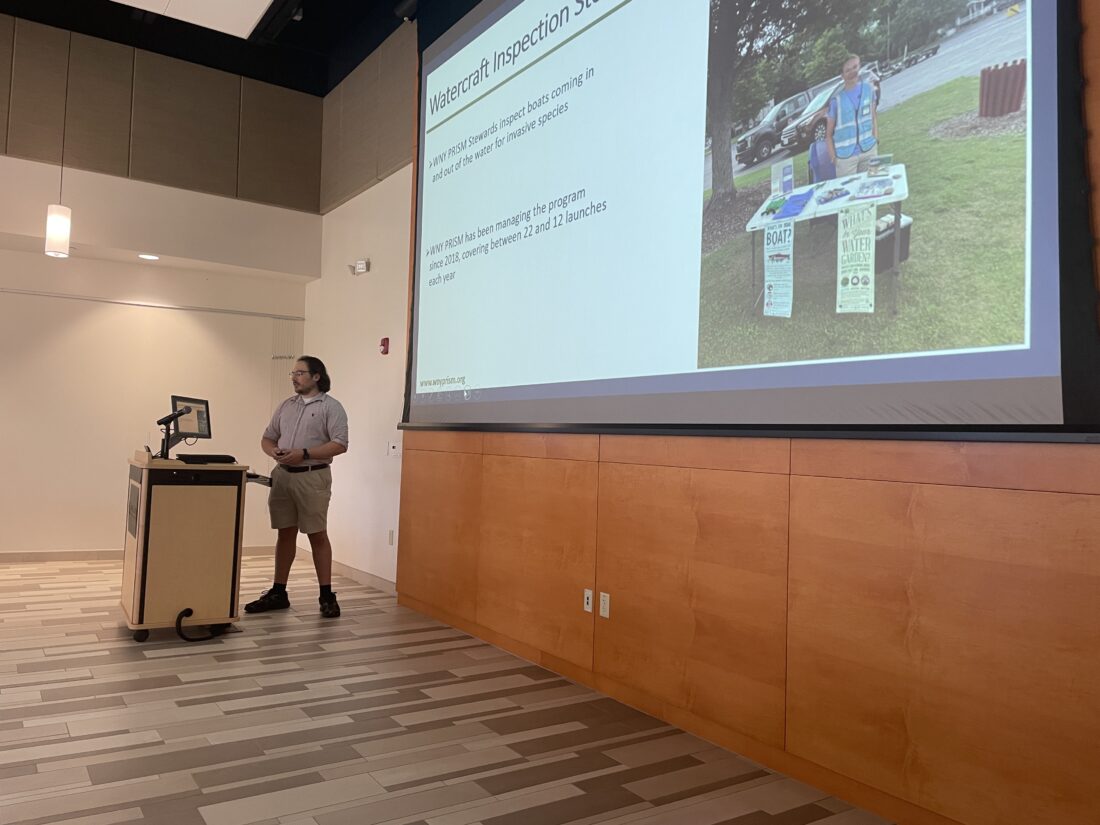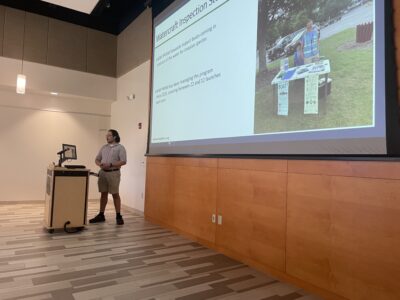Invasive Species Partnerships Continue

Western New York PRISM Aquatic Program Manager Nick Farese presents results from the 2025 regional watercraft steward program. Photo by Jay Young.
Chautauqua Lake was one of several key areas discussed at October’s Western New York Partnership for Regional Invasive Species Management partners meeting at SUNY Buffalo State.
There are eight different PRISMs spread across the state that coordinate programs to monitor, research, and manage the many different invasive species threatening our environment. The fall meeting gives stakeholders from around the region a chance to share results from their 2025 work and plan for next year.
Twan Leenders and the Chautauqua Watershed Conservancy lead the lake’s early detection and rapid response program. During the summer CWC staff are joined by volunteers on kayak paddles to different high priority areas of the lake. Main goals include the detection of any new invasives, monitoring, and management of certain species. For several years Leenders and his staff have led the removal of invasive water chestnut, which has a small population in the Chadakoin outlet. Because of its plant structure and relatively small numbers, water chestnut is being managed by hand pulling. Leenders has reported that around 450 plants were removed from the outlet during several events this year. Removal of somewhere on the order of a few hundred plants is consistent with past years. Active management of water chestnut, which can be spread to new areas by waterfowl, is also ongoing at the Audubon Community Nature Center.
Because invasive species are all so different, management tactics have to be adaptable. While water chestnut has been kept in check with manual removal, the recent arrival of starry stonewort is an entirely different challenge. Thanks to the state’s Invasive Species Grant Program (funded by the Environmental Protection Fund administered by DEC), the towns of Chautauqua and North Harmony were able to use diver-assisted suction harvesting (DASH) for the first time ever in 2025. This work took place at three different areas of growth over the course of ten weeks beginning in July. DASH is a highly targeted technique that allows workers to enter the water with a suction hose, remove the target species, and limit impacts to native plants and animals. Because of the sheer scale of the starry stonewort infestation, DASH worked alongside town of Chautauqua Mobitracs and Chautauqua Lake Association equipment performing bulk removal of the algae. Leenders and his staff have also taken point on monitoring for this program. Immediate results were promising, however it will take at least another growing season to assess the long-term effectiveness of this year’s work.
The Chautauqua Lake Association’s watercraft stewards are another key program focusing on invasive species prevention. In 2025 CLA staff were stationed at the lake’s public launches, where they interact with boaters, check for invasive species, and gather information on boater traffic and lake use. The various PRISMs and state agencies also station stewards at many different lakes, helping to generate and share valuable data about how our waterways are being used and the invasive threats they face. Stewards also encourage the public to ‘clean, drain, and dry’ their boats and equipment to prevent the spread of invasives to other lakes and rivers.
Keeping newer threats at bay is crucial for the lake’s future, as is the annual work that is done to manage well-established invasive species like Eurasian watermilfoil and curly-leaf pondweed. While we have been dealing with these plants for decades, stewards do their best to make sure they do not leave the lake and infest new areas. The Chautauqua Lake Partnership’s herbicide program also focuses on the yearly management of these more widespread invasives.
Linking all of this work together is the state’s iMapInvasives network at imapinvasives.org/. This database ensures that there is a record of invasive species detections and management actions, improving monitoring and coordination. Professionals and the public alike are encouraged to upload information into the system any time they discover an invasive species or undertake management. Thank you to everyone at Western New York PRISM for all the work that they do. More information can be found at wnyprism.org/. Also thank you to all of the local stakeholders working to prevent and manage invasive species, and all those who fund these programs.





